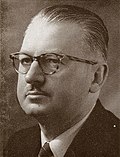List of presidents (1910–1980 and 1994–1997)
| No. | Portrait | Name (Birth–Death) | Term of office | Political party | |||
|---|---|---|---|---|---|---|---|
| Took office | Left office | Time in office | |||||
| Presidents of the First Senate (1910–1980) | |||||||
| 1 |  | Francis William Reitz (1844–1934) | 1 November 1910 | 10 March 1921 | 10 years, 129 days | South African Party | |
| 2 |  | H. C. van Heerden (1862–1933) | 11 March 1921 | 30 June 1929 | 8 years, 111 days | South African Party | |
| 3 |  | R. A. Kerr | 19 July 1929 | 16 January 1930 | 181 days | National Party | |
| 4 |  | Christiaan Andries van Niekerk (1874–1966) | 17 January 1930 | 18 January 1940 | 10 years, 1 day | National Party (until 1934) | |
| United Party (from 1934) | |||||||
| 5 |  | François Stephanus Malan (1871–1941) | 19 January 1940 | 31 December 1941 (Died in office) | 1 year, 346 days | United Party | |
| 6 |  | Philippus Arnoldus Myburgh (1880–1946) | 12 January 1942 | 31 December 1945 | 3 years, 353 days | United Party | |
| 7 |  | Pieter Jurie Wessels (1878–1958) | 18 January 1946 | 5 August 1948 | 2 years, 200 days | United Party | |
| (4) |  | Christiaan Andries van Niekerk (1874–1966) | 6 August 1948 | 19 January 1961 | 12 years, 166 days | National Party | |
| 8 |  | Jozua François Naudé (1889–1969) | 20 January 1961 | 31 May 1969 (Died in office) | 8 years, 131 days | National Party | |
| 9 |  | Johannes de Klerk (1903–1979) | 6 June 1969 | January 1976 | 6 years, 6 months | National Party | |
| 10 |  | Marais Viljoen (1915–2007) | 23 January 1976 | 18 June 1979 | 3 years, 146 days | National Party | |
| 11 |  | Jimmy Kruger (1917–1987) | 19 June 1979 | 31 December 1980 | 1 year, 195 days | National Party | |
| Post abolished (1 January 1981 – 20 May 1994) | |||||||
| President of the Second Senate (1994–1997) | |||||||
| 12 |  | Kobie Coetsee (1931–2000) | 20 May 1994 | 4 February 1997 | 2 years, 260 days | National Party | |
